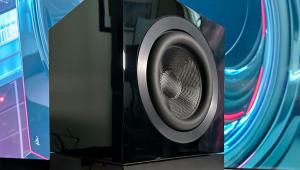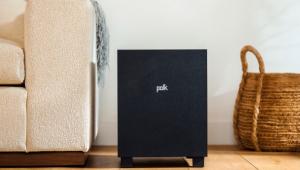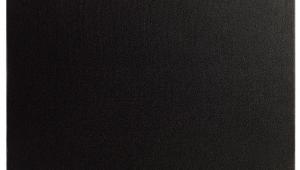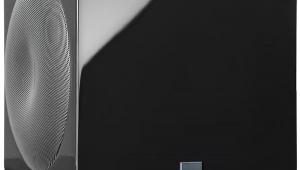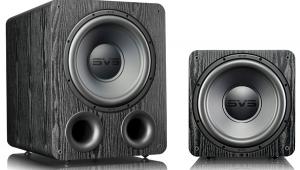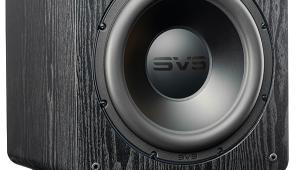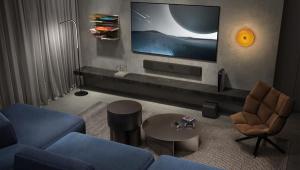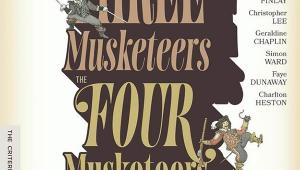Starke Sound SW15 Subwoofer Review
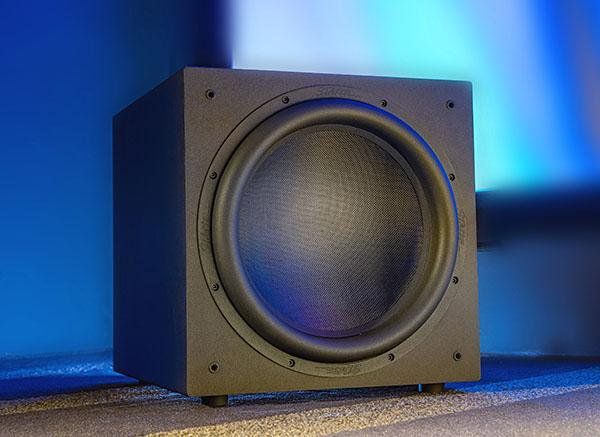
AT A GLANCE
Plus
Great value
Small for 15-inch subwoofer
Deep, rich sound
Minus
Generic appearance
Takes prodding to wake from standby mode
THE VERDICT
If you want the horsepower of a 15-inch subwoofer but can only accommodate an enclosure that typically comes with a 12-inch sub, the Starke Sound SW15 might be where your search ends.
Subwoofers, an essential component for every home theater system. Unless you have an extraordinary set of speakers the same holds true for a two-channel setup, you need a sub to reinforce the bottom end. While their contribution is critical for the reproduction of full-range sound, for the most part they aren’t much to look at.
Often little more than square black cabinets, subwoofers rarely enhance the aesthetics of your HT room. I’ve reviewed over 50 of them in the past 12 years and in that time, very few have visually differentiated themselves from the rest. The Starke Sound SW15 is no exception from an appearance perspective, but can it stand out from the crowd in some other way?
Price would be the first potential area, you certainly won’t find many quality sealed subwoofers with a 15-inch driver selling for $699. Starke Sound has the cost aspect covered, but what about sound quality and performance?

Benjamin Franklin is attributed with having said “the bitterness of poor quality remains long after the sweetness of low price is forgotten”. In other words a low purchase price is an initial win perhaps, but over the long haul you may regret not having spent more. Thus far the scorecard shows that appearance can be considered fairly generic and the price is quite reasonable. The only thing left to determine is how the SW15 performs, that’s where we’ll concentrate for the rest of this article.
Impressions
The SW15’s enclosure is about as small as you can get for a 15-inch subwoofer, so much so that at first I thought Starke may have sent me their 12-inch version by mistake. Glancing over at the model number silk screened onto the plate amp showed it was indeed the SW15. This subwoofer is certainly living room friendly. Starke sent me SW15’s in both available finishes; the black version uses a matte wrap with a slight texture, while the white wrap uses more of an eggshell-type finish. Neither are glossy. The cabinets have a very slight roundover at the edges which softens the boxy look somewhat.
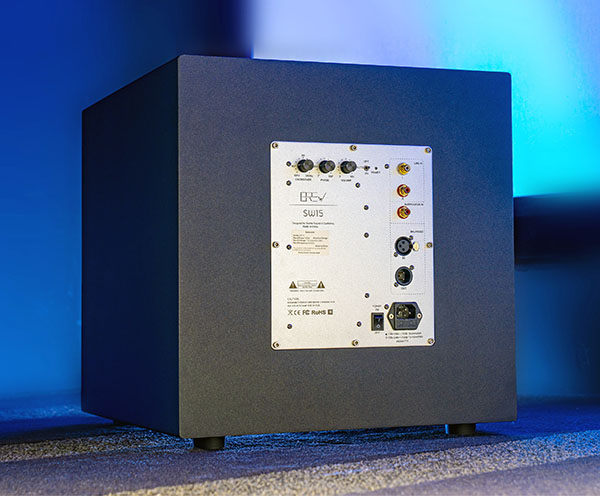
For folks who want their subwoofer to blend in with the decor I suggest you leave the SW15’s grille on. It’s a nice looking fabric mesh over a 1.5” thick MDF that’s been painted black, the outer edges are beveled at a 45° angle to incorporate some style. Located on the top is a BREV logo plate with a brushed aluminum finish that has the same shape as the grille itself (BREV is short for Brevity, Starke Sounds more price-focused product line). It looks rather classy. If you would prefer a more industrial feel however, you’ll want to take the grille off.
The SW15’s driver has a menacing appearance; the cone material looks like raw carbon fiber. With no protruding dust cap, you essentially get one big bowl of it. The surround is of the high-roll variety - rather than the typical and more shallow half-roll variant—which further enhances the threatening nature. That visual becomes even more appealing when you push the SW15 and see just how far the cone moves back and forth, it’s actually kinda fun to watch if I’m honest. While the grille is a very stout piece, and does have a stylish air to it, I left it in the box because I wanted to watch the driver in action.
Small detail alert… recently I’ve taken to highlighting seemingly trivial features that differentiate one subwoofer from another. In a world of outwardly indistinguishable products, the quest to identify unique characteristics has become increasingly important to me. This time however, it’s not directly about the SW15, but Starke Sound specifically.
Generally speaking, when you buy from an internet direct company you can pay with a credit card and sometimes PayPal.
That’s typically it though. Starke accommodates far more options, listed in alphabetical order: American Express, Apple Pay, Diners Club (does that still exist?), Discover, Google Pay, MasterCard, Meta Pay, PayPal, Shop Pay, Venmo and Visa.
Listening/In Use
At the time of this review Starke ran a special of two subs for under $1,000, so I requested Starke send me a pair, and why not? If I were in the market for a subwoofer like this I’m for sure taking advantage of an offer like that. One of the true benefits of multiple subwoofers is they can be used to balance out the frequency response in the room. That’s assuming you have latitude to place them in ideal locations and can use a measurement system to fine tune their individual output. I’m not in the position to place subs in different parts of my room unfortunately so I resorted to stacking them one on top of the other.
When working with more than one subwoofer—regardless of where they are placed in a room - you have to ensure their respective outputs are the same at the MLP (Main Listening Position) for a given AVR volume as you don’t want one sub handling more of the load than the other(s). Gain matching in a multi-subwoofer scenario has some drawbacks however; manufacturing differences mean the output from subwoofer A set at the 12 o’clock position on the dial might not be the same as subwoofer B set the same way (“gain” in this case means the “volume” knob on the subwoofer’s amplifier). My preferred method is to independently level match each sub using an SPL meter while seated at the MLP, which is what I did with the SW15’s. Once I knew they were both equally matched it was time to get serious.
With few exceptions, small subwoofer cabinets mean a lot of DSP (Digital Signal Processing) has been applied to shape the output. This digital wizardry is an attempt to overcome limitations associated with physics. “Attempt” is the key word, however, as laws of physics are unyielding, meaning algorithms can only go so far. If an amplifier and driver combination are not specifically designed to be used in a compact enclosure, the amount of DSP required tends to affect not only the sound quality, but also output capabilities. That means bass can sound strained at high volumes, loose detail or have limited dynamic range. None of that is good of course.
A rough approximation of how much DSP has been applied can often be gleaned by the amount of distance added when you run your receiver's room EQ; the greater the number of feet beyond the actual physical distance, the more DSP there is. When I ran room EQ on the Starke Sound SW15, physical distance versus calibrated was a mere 2 additional feet. Based upon past experience with this AVR and many other subs, that’s a low number. Translation: there’s probably little in the way of DSP applied, something my ears verified as I started to put the SW15 through its paces.

When I started to push things one of the original units Starke sent me did suffer an amp issue. As I got daring with the volume knob it would shut down. It wasn’t a thermal protection circuit as the problem would occur even if the sub was only on for a minute or two. Starke promptly swapped it with another unit; the replacement never shut off unexpectedly during the five weeks I had the SW15’s in rotation. During that time it was driven hard on many occasions.
Movies
Given that I had roughly the equivalent of a 21” driver with this pair of SW15s I decided to focus on movies with particularly difficult soundtracks. I emphasized scenes that had either very deep bass passages, lots of complex action, long durations of intense activity or some combination of at least two of those. What I’ve led off with recently is the opening from Edge for Tomorrow, and I saw no reason to change that approach for this review.
Although I stuck with my typical MO, I changed it up slightly because I had a pair of subwoofers. Rather than beginning at a toned-down volume level and work my way up, I decided to cut loose and crank it from the get go. As the soundtrack inched through the 5 different levels of the opening sequence the SW15’s drivers pulsated wildly, yet not a single unpleasant sound was heard. The first three plateaus in the series were definitively strong - in your face almost - but by the time it got to the last two things tapered off. With the firepower I had staring at me I thought there would be a bit more of a guttural impact with obvious vibrations sent through the floor. The amp was seemingly protecting the driver, but I did wonder if it was maybe a bit too effective.
13 Hours is the story of the siege on a CIA outpost in Libya during 2012. The firefight at the compound starts halfway through scene 15, kicking off the action with a bang (no pun intended). There’s an ominous soundtrack that heralds the impending doom; rumbling undertones lent a foreboding sense of what was about to happen. As the combatants open fire on each other their weapons had a sharp, crisp sound with a lot of intensity. Mortars hit with force, exploding with a resounding thud. Every weapon and different type of ordnance was distinct, each having their own sound signature.
In Flight of the Phoenix, captain Frank Towns is sent to the Gobi Desert in Mongolia to pick up a group of people and fly them back home after the oil field they worked in was shut down. Shortly after takeoff the plane encountered a fierce sandstorm, the wind from which produced a prominent low intensity grumbling sound. Not long into their the flight the plane encounters problems, as it tumbles toward earth there’s a pulsating effect that was very pronounced. Once the plane makes contact with earth it begins skipping across the desert sand, creating assertive thumps each time it pounded off a dune.
Despite some difficult material played at high volume the amplifier on both units registered almost no warmth—they didn’t seem the least bit fazed by any of it.
Music
After the admirable performance from the Starke Sound SW15 during the movie tests, I had high hopes for the music portion of this assessment. My anticipation was the detail heard from the film soundtracks would carryover and I would be equally impressed. Given that, I decided to use material from my catalog that I particularly enjoy.
Joe Satriani’s Live in San Francisco is an old favorite of mine. Not only do I like the music but the recording itself is of a very high quality. I went straight to the song with perhaps the fattest bottom end of the entire performance that night, “House Full of Bullets.” Stu Hamm’s bass anchors this one with a driving, melodic rhythm that was oh so clear and well defined. It was both powerful and heavy, yet tuneful. Jeff Campitelli’s kick drum pounded away in unison, omnipresent, overlaying the bass brilliantly. This is a rollicking blues tune the SW15’s ate up.
The opening salvo of Hans Zimmer Live in Prague is a medley consisting of “Driving”, “Discombobulate” and “Zooters Breakout.” Those three set the tone for the rest of this disc. They slowly build to a towering crescendo, beautifully crafted by the 70+ musicians that grace the stage by the end. Inevitably I’m playing this one loud. To put it more accurately, I’m playing this one loud. As the musicians start coming in the sound gets hectic and lively, yet the SW15’s seemingly enjoyed the challenge. The upright bass and electric bass guitars, drums, and tympani are all recorded on the hot side, but not excessively so. They underpin this composition, producing a sound that was rich, warm and inviting.
Forgoing what was fast becoming a trend in this evaluation—live recordings—I opted to close out the music section with a studio track instead, featuring a song from a very long time ago. From Pink Floyd’s seminal album Dark Side of the Moon, I went with “Time.” That pulsating double-beat that occurs at the beginning was lush and striking, despite the other instruments being recorded louder. The plucked strings from the bass guitar rang out with authority, immediately grabbing my attention. At first they have a very Rickenbacker sense to them, with the more trebly tone that bass guitar is known for. When the song kicks into the rhythm itself, it quickly becomes apparent Roger Waters is now using his more customary Fender Precision, with its meaty sound. The Starke Sound SW15 handled all of it with poise.
Conclusion
If you’re short on space, but have no desire to skimp on output or sound quality, you should check out the Starke Sound SW15. Its diminutive size and low cost belie what this subwoofer is capable of. The bass is unmistakable, without being obnoxious or overbearing. The SW15 checks all the right boxes.
Test Bench
.jpg)
Fig.1 Measurements were taken using an OmniMic. The subwoofer was positioned in the center of my listening room with the microphone tip 1 foot from the driver dustcap. The controls were set as follows: Volume 100, crossover 200Hz, phase: 0°.
Specs
Driver: 15-inch glass fiber sandwich cone
Amplifier: 450W RMS, 900W peak
Frequency Response: 14Hz-240Hz ±3dB
Crossover: 50-200Hz, variable
Phase: 0-180 degrees, variable
Power: On/Off/Auto
Inputs: 1 XLR (balanced), 3 RCA (unbalanced) left/right/LFE
Outputs: XLR
Dimensions: 17.3” x 16.5” x 18.9” (HWD), including feet
Finish: Black (textured), white (smooth)
Weight: 55 lbs.
Warranty: 3 years



